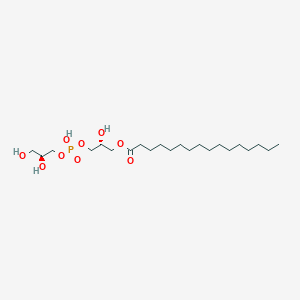| Full List of Protein(s) Regulated by This Metabolite |
| GPCR rhodopsin (GPCR-1) |
|---|
| G-protein coupled receptor 55 (GPR55) |
Click to Show/Hide the Full List of Regulating Pair(s): 1 Pair(s)
|
| Detailed Information |
Protein Info
 click to show the details of this protein click to show the details of this protein
|
| Regulating Pair |
Experim Info
 click to show the details of experiment for validating this pair click to show the details of experiment for validating this pair
|
[1] |
| Introduced Variation |
LysoPG(16:0/0:0) addition (48 hours) |
| Induced Change |
GPR55 protein activity levels: increase |
| Summary |
Introduced Variation

 Induced Change
Induced Change

|
| Disease Status |
Healthy individual
|
| Details |
It is reported that lysoPG(16:0/0:0) addition causes the increase of GPR55 protein activity compared with control group. |
| Transferases (EC 2) |
|---|
| Signal-regulated kinase 1 (ERK1) |
Click to Show/Hide the Full List of Regulating Pair(s): 1 Pair(s)
|
| Detailed Information |
Protein Info
 click to show the details of this protein click to show the details of this protein
|
| Regulating Pair |
Experim Info
 click to show the details of experiment for validating this pair click to show the details of experiment for validating this pair
|
[1] |
| Introduced Variation |
LysoPG(16:0/0:0) addition (0.08 hours) |
| Induced Change |
MAPK3 protein phosphorylation levels: increase |
| Summary |
Introduced Variation

 Induced Change
Induced Change

|
| Disease Status |
Healthy individual
|
| Details |
It is reported that lysoPG(16:0/0:0) addition causes the increase of MAPK3 protein phosphorylation compared with control group. |
| Signal-regulated kinase 2 (ERK2) |
Click to Show/Hide the Full List of Regulating Pair(s): 1 Pair(s)
|
| Detailed Information |
Protein Info
 click to show the details of this protein click to show the details of this protein
|
| Regulating Pair |
Experim Info
 click to show the details of experiment for validating this pair click to show the details of experiment for validating this pair
|
[1] |
| Introduced Variation |
LysoPG(16:0/0:0) addition (0.08 hours) |
| Induced Change |
MAPK1 protein phosphorylation levels: increase |
| Summary |
Introduced Variation

 Induced Change
Induced Change

|
| Disease Status |
Healthy individual
|
| Details |
It is reported that lysoPG(16:0/0:0) addition causes the increase of MAPK1 protein phosphorylation compared with control group. |
|
|
|
|
|
|
|
 click to show the details of this protein
click to show the details of this protein
 click to show the details of experiment for validating this pair
click to show the details of experiment for validating this pair
 click to show the details of this protein
click to show the details of this protein
 click to show the details of experiment for validating this pair
click to show the details of experiment for validating this pair
 click to show the details of this protein
click to show the details of this protein
 click to show the details of experiment for validating this pair
click to show the details of experiment for validating this pair

